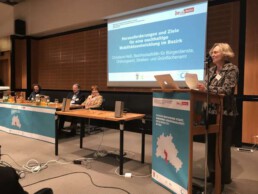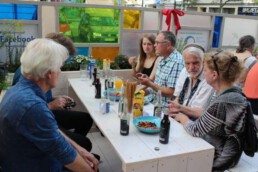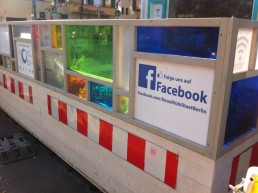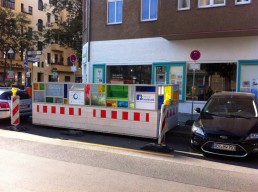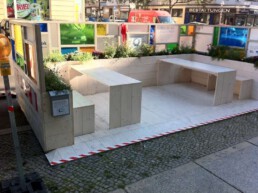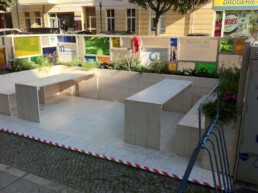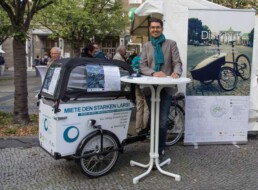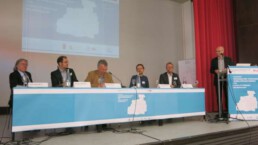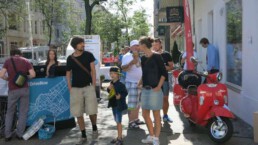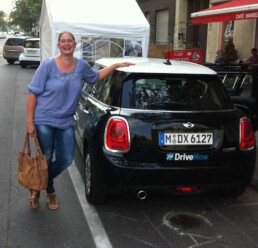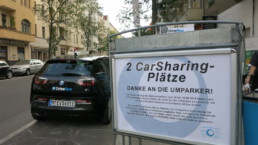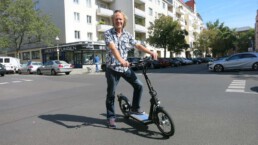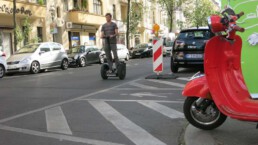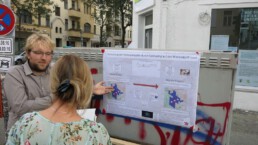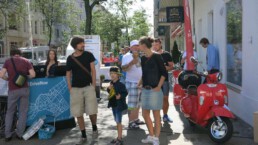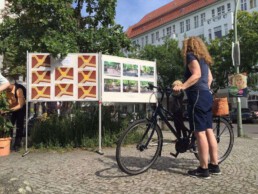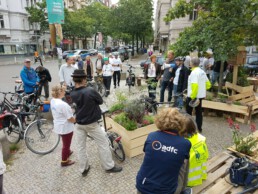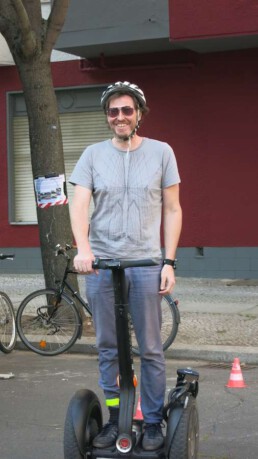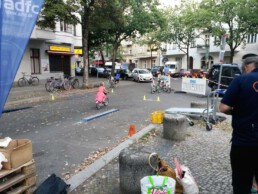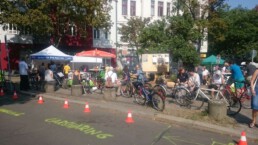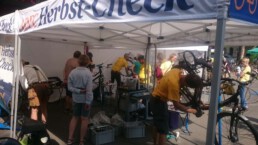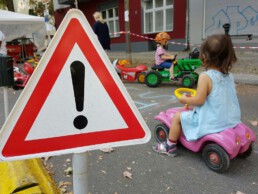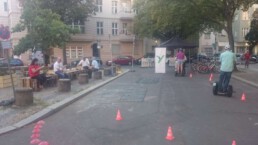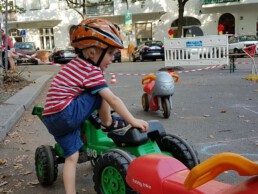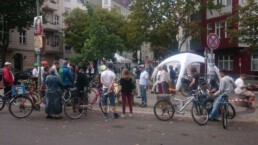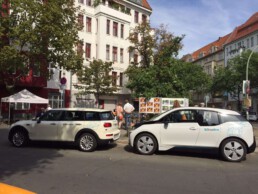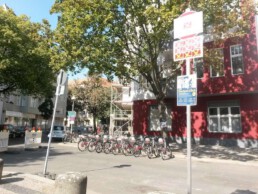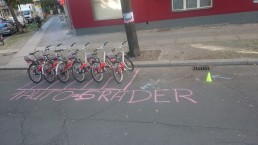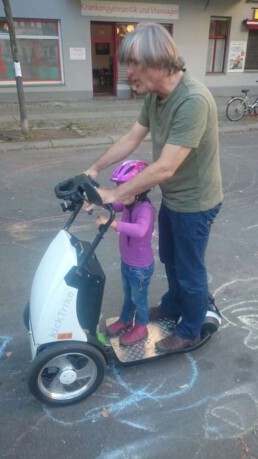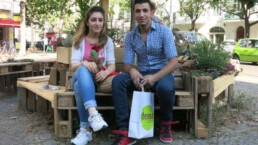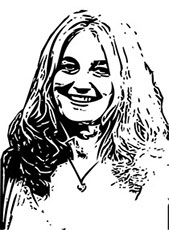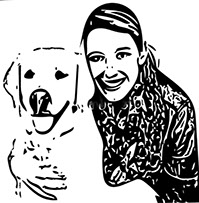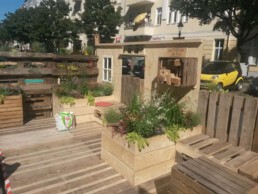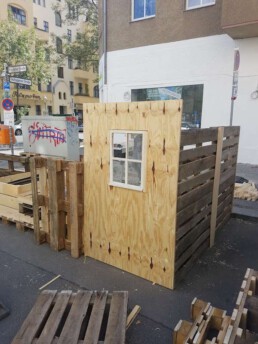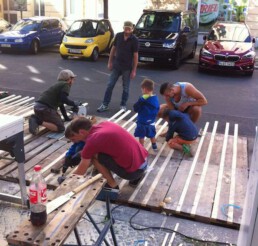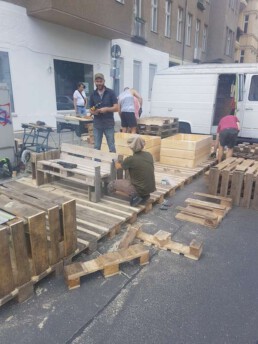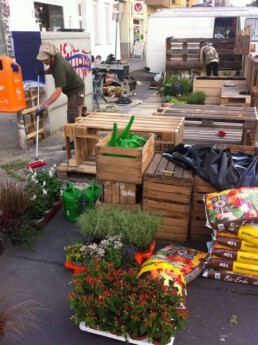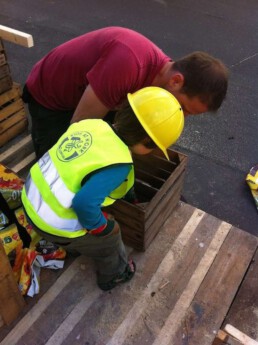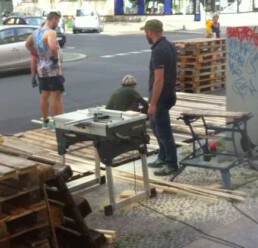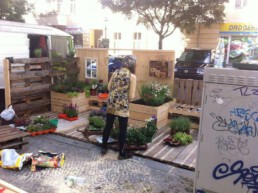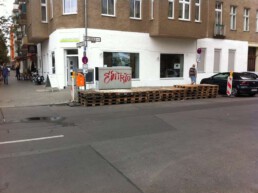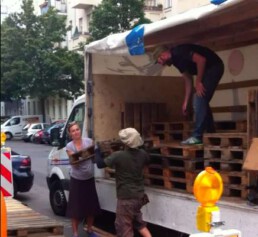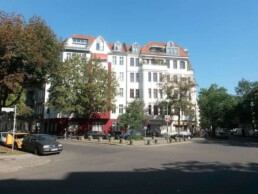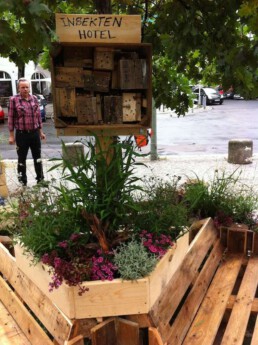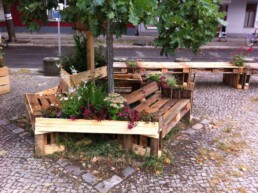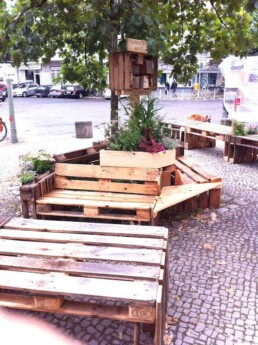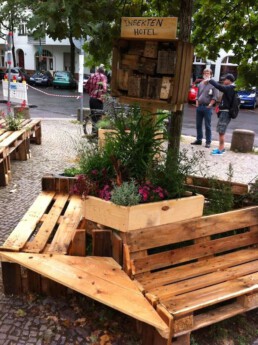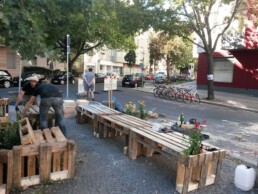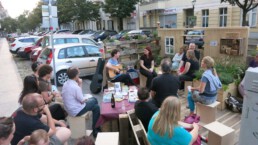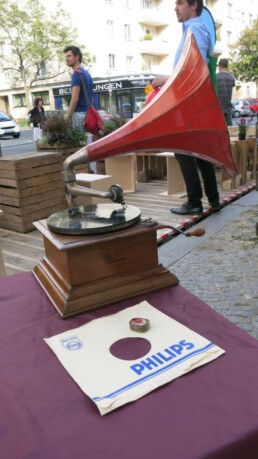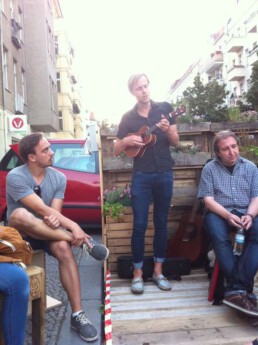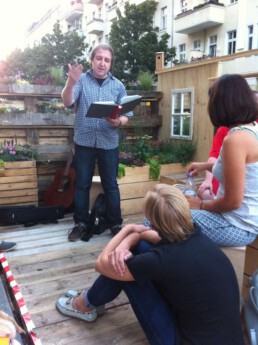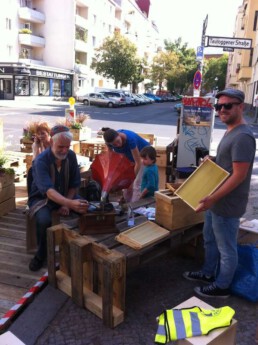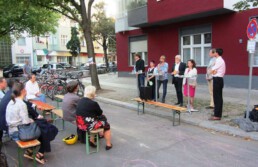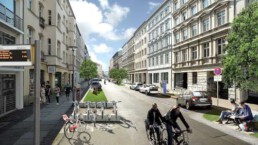"Growing City, Sinking Quality of Life?" Symposium
New mobility: getting Tempelhof-Schöneberg ready for the future
Berlin’s population is expected to reach 4 million people by 2030, bringing 130,000 additional vehicles onto its roads. Already today, the city is close to a traffic infarct and different innovative public space concepts compete against each other. Christiane Heiß, district councillor for citizen services, the public order office, the regional office of public roads and green space, and the project New Mobility Berlin collaborate to limit conflict and concern through innovative concepts of mobility.
On February 15, 2018, under the motto “Growing city – sinking quality of life?” about 100 mobility experts discussed inside the town hall of Schöneberg about:
- What problems exist in the district regarding space requirements of motorized private transport
- Ideas and solutions regarding how mobility services can improve quality of life in Berlin
- Which initiatives in Tempelfhof-Schöneberg take action to make public space safer and better for all road users?
"The mobility turnaround in Berlin is in full swing – I support this because mobility as a service creates many advantages for the city and its inhabitants!"
- Christiane Heiß, district councillor for traffic in Tempelhof-Schöneberg
"Primarily to relieve the inner-city streets from unnecessary traffic, we strongly rely on parking space management."
— Hartmut Reupke, Senate Department for the Environment, Transport and Climate Protection
Energetic at all levels
To set the course for a car-reduced future, participants demanded a state-district cooperation in relation to mobility and liveable neighbourhoods. Whether cycling highways, improved public transport or broadened parking space management, what is needed are constructive concepts which are perceived by the majority of people as feasible and worthy of support.
Also a sustainable improvement of the framework for mobility as a service (MaaS) was on the agenda. That more Berliners get rid of their private vehicles and instead use the public transport, carsharing, scooter-sharing or (cargo) bike-sharing, was a request of the participants. The freed up space in the neighbourhood could thus be rethought and redesigned by citizens and administration.
"The goal of the project NEUE MOBILITY BERLIN is to reduce the space requirement of stationary traffic and thus to increase the quality of life in the city!"
- Dr. Gabriele Wendorf, Center for Technology and Society (TU Berlin)
Plausible parking space management
Parking space management, which has been successfully implemented in parts of the city, were brought up often during the discussion. In the opinion of the assembly, it brought more freedom for future planning. Bigger negotiable areas in public space would allow to scale up e-mobility concepts and its associated and necessary charging infrastructure. Thanks to an efficient use of the carpark offering, the traffic in search for a parking space, as well as parking violations such as second lane parking could be reduced. Residents, businesses and trade benefit from better accessibility of free parking spots.
Need-oriented city
It was also noted that convenient consumer offers such as e-bikes and pedelecs, mobility apps and delivery services dynamically change the daily life of the urban population. Hence, personal dependence on privately owned cars decreases. How public space can and must adapt to these as well as future usage scenarios should be negotiated in close cooperation between all stakeholders in Tempelhof-Schöneberg.
"It is essential to keep in mind what exactly urban society requires."
- Hartmut Reupke, Senate Department for the Environment, Transport and Climate Protection
Summer in 2017's garden lounge
Summer 2017 in our garden lounge
On July 30, 2017, Berlin’s city district councillors Oliver Schruoffenegger (Urban Development, Construction and the Environment in Charlottenburg-Wilmersdorf) and Arne Herz (Citizen Services, Economic and Regulatory Affairs) ceremoniously opened the garden lounge of NEUE MOBILITÄT BERLIN. In front of the business premises of insel-projekt.berlin they cut the red ribbon and invited numerous guests and residents to an extensive exchange about the current transformation of public parking space.
For over 2 months, the garden lounge was placed on 2 adjacent parking lots. It was used as a hangout place and event location where citizens could socialize and make new acquaintances.
During the previous year, at the same location the “bring-your-pillow” lounge was built with Euro pallets. This popular seating area was very well received in 2017 so that it was meant to be renewed this summer in form of a handcrafted and high-quality designer garden lounge.
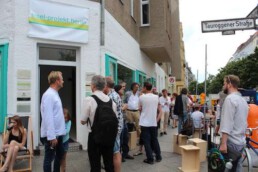
Constructed with the help of a master carpenter the parklet was predominantly made of PEFC-certified wood and colored upcycled acrylic glass. It was decorated with flowers and herbs from the Mosaik Gärtnerhof Charlottenburg in Fürstenbrunner Weg.
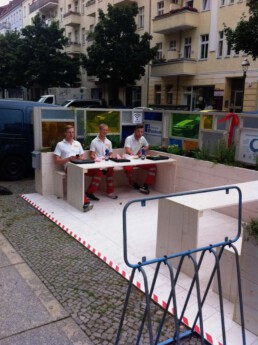
In the 10-week period from mid-July to the end of September 2017, the International Cooperation Corporation (GIZ) and the Agora Transport Transformation with 70 traffic planners from around the world were recieved among others at the garden lounge by NEUE MOBILITÄT BERLIN. On September 16 and 17, as part of the European Mobility Week, innovative forms of mobility were tested such as the electric car BMW i3 from the DriveNow fleet, a prototype of the BMW Motorrad X2City (pedelec scooter) and a electric scooter by COUP. In addition, mobility providers such as drive-by and nextbike presented their services to interested passers-by.
The TU Berlin, in cooperation with the DorfwerkStadt e. V., addressed “Opportunities and Limits of Citizen Participation in the District” and the Competence Center for Urban Mobility of the BMW Group informed about “Ideas and Concepts for Sustainable Urban Mobility & Quality of Life”.
The NEUE MOBILITÄT BERLIN project also encouraged a critical questioning of the action and communication area. Under the motto “They are taking away our parking lots”, neighbours who previously did not feel sufficiently informed about the motives and objectives of the research project were approached. This was also the case for those who had a fundamentally different idea about how public urban space should be used.
Of course, the garden lounge also offered the possibility of purely private chatting, entertaining stay and pausing. Coffee & cake from the bakery next door or the lunch break could be enjoyed here.
Children played in the sunshine, babies were breastfed and even in rainy weather the free Wi-Fi attracted its "owners" to this "oasis in the asphalt jungle“.
— Rolf Mienkus, insel-projekt.berlin UG (haftungsbeschränkt)
On September 29, a closing event was held together with friends and acquaintances as a farewell to the summer. Dagmar Eichhorn presented in her inimitable way the Turkish basil girl fairy tale, a delicious snack satisfied the arisen hunger and the winners were drawn for a free day trip with the electric cargo bike LARS.
How to continue with the parklet in the upcoming years?
This has not been clarified yet – but we are always open for exciting suggestions!
6th Energy Day in the Moabit District
NEUE MOBILITÄT BERLIN (NMB) at the
6th MOABIT ENERGY DAY
On September 7, 2017, NEUE MOBILTÄT BERLIN (NMB) participated for the first time at the MOABIT ENERGY DAY. Invited by the Moabit Company Network, Rolf Mienkus (insel-projekt.berlin UG) gave a brief overview of the prerequisites, the conditions and the results of the NMB research project at the Info-Workshop 1 “Sustainable Mobility and City-Logistics”.
The idea of convincing people of the advantages of multimodal mobility without making use of a privately owned car was met with great interest. This concept was consolidated by the speeches of representatives of the Berlin Agency for Electromobility (eMO, Frank Panse, “Sustainable Mobility in Urban Commercial Transport”) and BEHALA (Klaus-Günter Lichtfuß, “The Fully Electric Supply Chain for Sustainable Urban Logistics of Tomorrow”).
Subsequently, NMB moved to its exhibition stand in front of the City Hall Tiergarten (see photo, copyright: STATTBAU GmbH). LARS, the electric (rental) cargo bike which was acquired as part of the project, was displayed together with a roll-up banner of “Distribut-e – Green Supply Chains for the City of Tomorrow”, a joint research project of the TU Berlin and insel-project.berlin UG.
"The 6th Moabit Energy Day was a most welcome opportunity to engage in a cross-district neighbourly exchange."
— Rolf Mienkus, insel-projekt.berlin UG (haftungsbeschränkt)
The well-attended event on energy efficiency and climate protection served as a showcase for local neighbourhood projects related to the urban development concept of Green Moabit, as well as the offers of major players such as Vattenfall and BSR.
The bottom line was clear: crossing the border of the Mierendorff-ISLAND has paid off for NEUE MOBILITÄT BERLIN. New contacts were established and existing ones were deepened. The exchange between the two neighbourhoods about innovative mobility approaches is to be further developed, in spite of or precisely because of their location in two distinct districts.
Symposium on "Sustainable Urban Mobility Blueprints"
Shaping the future of mobility in Charlottenburg-Wilmersdorf
In the current legislative period, urban development policy directions for Charlottenburg-Wilmersdorf are to be reoriented.
The municipal focus will be on improving urban living standards through innovative mobility concepts, among other things.
The symposium on “Sustainable Urban Mobility Blueprints” attracted more than 70 experts for a district-wide cooperation to find an answer to the following question:
“How can an improved mobility offer in the city create more quality of life for all residents?
One approach is the promotion of multimodal mobility while simultaneously reducing individual motorized transport. To this end, the “New Mobility Berlin” project presented its needs-oriented approach on the Mierendorff-ISLAND and in the Klausenerplatz-Kiez.
"An essential component of the future development of the district, and thus of the entire city, is characterized by the day-to-day mobility decision of its inhabitants."
- Oliver Schruoffeneger, city district councillor for urban development, construction and the environment in Charlottenburg-Wilmersdorf, Berlin
"Only a constructive, dialog-oriented approach to urban mobility and quality of life can lead to future-oriented, needs-oriented solutions."
— Dr. Gabriele Wendorf (ZTG/TU Berlin)
Looking into the future
We do not know which mobility models will prevail and be accepted by citizens, but we do see new potential and solutions emerging in international cities. Inner cities are reacting to the increasing lack of space and other side effects of the strongly increasing traffic volume, such as pollutant emissions or noise pollution. Some cities, for example Singapore, Oslo (toll) or Copenhagen (car-free zones) succeed by setting the right framework conditions in minimizing these negative effects while still addressing residents’ mobility needs.
Ultimately, the cities and municipalities themselves remain in control of adapting their mobility offers in such a way that the quality of life in the city can be improved without a significant limitation of mobility.
"A post-fossil mobility network is emerging. Hence, more important than ever, are real time experiments in which the transformation of transport can not only be tested but also lived."
- Dr. Weert Canzler (Science Center Berlin for Social Research / WZB)
Perspectives for the district
The counting community agreement provides concrete action steps for traffic in Charlottenburg-Wilmersdorf. Within the framework of the current legislative period, noise and exhaust gas emissions have to be reduced while car sharing and e-mobility have to be promoted. Modern mobility for all and special consideration of bicycle and pedestrian traffic are planned. Last but not least, the goal of sustainable mobility is to be complemented by appropriate educational programs on transport for children and young people.
In order to achieve these goals, it is not enough merely to align the planning side with these objectives. With regard to mobility, this means: how attractive the citizens may consider one or other means of transport depends on their individual situations and on the perceived and respectively used range of alternatives.
"Citizens are experts for the current situation on site, and we need to become more familiar with their expectations about public space and transport offers in the neighbourhood."
- Oliver Schruoffeneger, city district councillor for urban development, construction and the environment in Charlottenburg-Wilmersdorf, Berlin
Mobility days in 2016's action weeks
A perfect occasion to present innovative approaches to urban mobility in Berlin, at 2016’s “Days of New Mobility” on Saturday, September 3, on the Mierendorff-ISLAND and Sunday, September 4, at the Klausenerplatz-Kiez.
From 1 to 6 p.m. and 10 a.m. to 6 p.m. respectively, people enjoyed electric scooters by eMio and Segways by yoove Mobility, among other electric vehicles.
The prototype of the BMW e-Kick-Scooter, a scooter with electronic support, was exhibited for the first time.
"Amazing, finally I can find a parking spot close to my flat thanks to the carsharing vehicles."
— Kerstin R., neighbour
2 Action Weeks, 2 Pilot Neighborhoods
From August 28 to September 10, 2016, alternative uses of public space and different mobility offers were put in place in the pilot neighbourhoods Mierendorff-ISLAND and Klausenerplatz-Kiez to provide more quality of life to residents.
We would like to thank the car owners that parked their cars at a location outside the pilot areas for the duration of the action weeks. This way, they made space for a temporary redesign of parking areas, without losing any parking spaces or adding further parking pressure in the neighbourhoods. Most importantly, they agreed to test their own mobility behaviors for two weeks without their private car.
Two parking spots per pilot area were redesigned for carsharing purposes, to ensure availability of vehicles for those who moved their private car to a different parking space.
The action weeks for both neighbourhoods were conceived by local residents and entrepreneurs in three public meetings. Ideas for improving mobility and urban life have been developed and implemented, in accorance with local public space regulations.
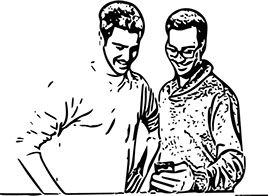
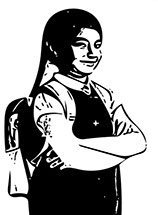
"We were able to show the citizens what other kinds of mobility there are by now."
- Birger Prüter, Climate Protection Management Klausenerplatz-Kiez
Discover the details of the NMB Action Week 2016
Action weeks Mierendorff-ISLAND + Klausenerplatz-Kiez
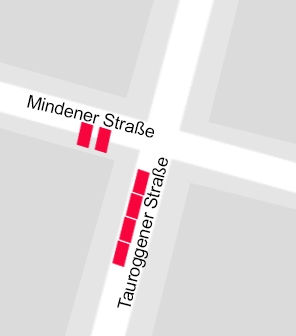 Since the 28th of August, you have been able to familiarize yourself with the advantages of car and bike sharing on the Mierendorff-ISLAND in Tauroggener Strasse and in the Klausenerplatz-Kiez on the square Horstweg / Wundtstrasse, as well as learn about the results achieved so far.
Since the 28th of August, you have been able to familiarize yourself with the advantages of car and bike sharing on the Mierendorff-ISLAND in Tauroggener Strasse and in the Klausenerplatz-Kiez on the square Horstweg / Wundtstrasse, as well as learn about the results achieved so far.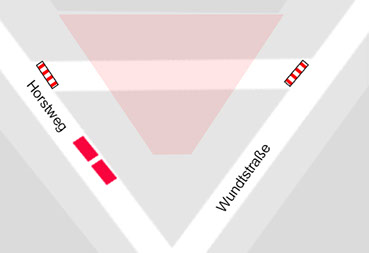
You have been showed how to reserve, unlock and return a car sharing vehicle.
Many people took advantage of the opportunities to get familiar with the special features of electric cars in the car sharing fleet.
The Call a Bike station of the Deutsche Bahn, which was placed on the temporarily restricted areas during the action weeks in the Klausenerplatz-Kiez, brought further alternative possibilities of the movement into the view. This way we complied with the desire of those who are looking for a simple, flexible form of mobility.

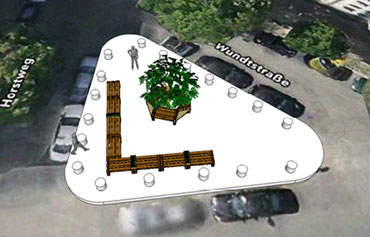
During the first action week the “Bring-Your-Pillow-Lounges” were created in Mindener Strasse and on the square Horstweg / Wundtstrasse. From pallets as a foundation, we built a space that would allow you to linger, get in touch with each other, invite and get to know each other. This supportively interacting, predominantly native flowers and grasses were used for planting. Plant tubs and the free spaces in the vertical placed pallets offered enough room for this purpose.
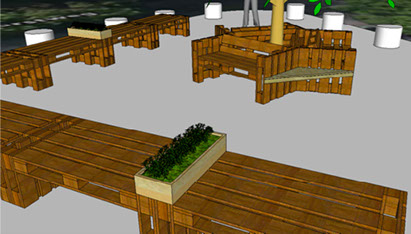
Our schedule for the Mierendorff-ISLAND and Klausenerplatz-Kiez showed what to expect in the lounges and on the other areas.
On the Mierendorff-ISLAND, for example, you were able to enjoy the “Lachen statt Fernsehen” -festival 2016 every night from 7 to 9 pm.
Well-known and unknown Berlin artists presented self-written music and texts.
In the Klausenerplatz-Kiez you were able, among other things, to find out about the available options for the elections to the House of Representatives of Berlin and to the City District Council Assembly on the 18th of September 2016 during a politician meeting in Berlin on Wednesday, September 7.
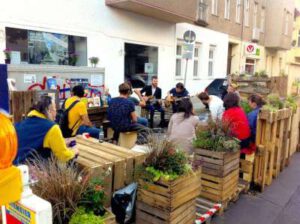
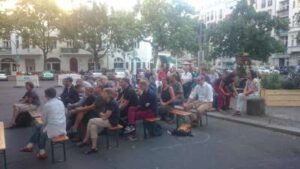 Whether film, live music or a gramophone concert – we had put together attractive points for you and were also open to spontaneous performances or offers from you.
Whether film, live music or a gramophone concert – we had put together attractive points for you and were also open to spontaneous performances or offers from you.
Thank you for your fantastic contributions!
On the central weekend in the action weeks we organized an explicit mobility day in each of the two model areas. Further information in the article: “Mobile ideas for a society in transition”
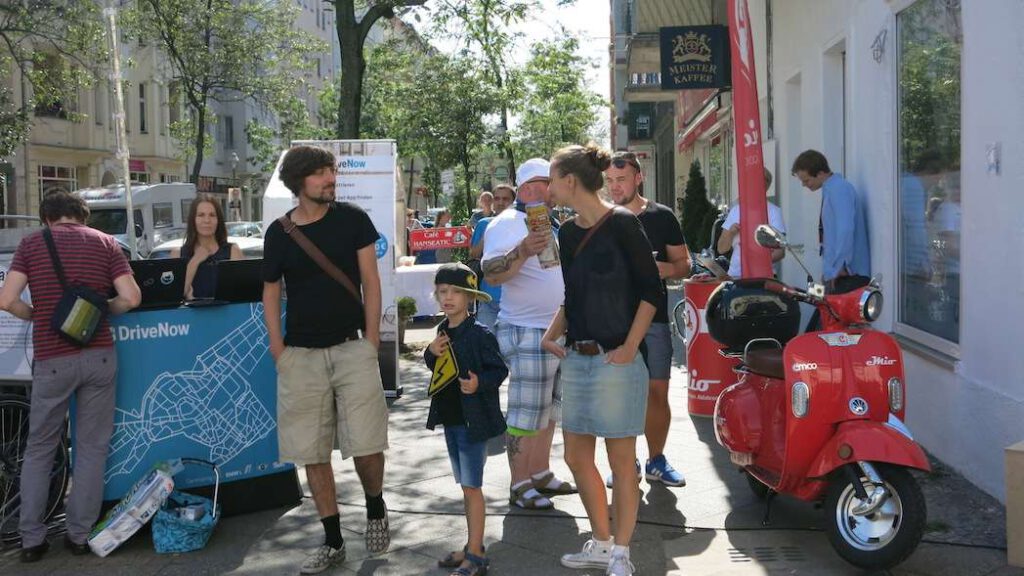
Mobility from Scratch
Neue Mobilität Berlin (NMB) examines the possibilities and limitations of local mobility.
Exemplary for Berlin, specific questions are asked in the Charlottenburg district, on the Mierendorff-ISLAND and the Klausenerplatz-Kiez:
- How do I move through my neighbourhood and across town as a youngster, professional or elderly person?
- What type of problems do we face and how can they be solved?
- Which and how much traffic do we want in our neighbourhood?
- What alternatives exist?
- Who can provide specific on-site support and how?
Last but not least:
- How is mobility related to individual and public quality of life?
The goal: great quality of urban life
The NMB project wants to inspire locals to upgrade their own environment in a sustainable way through innovative mobility concepts.
The project team:
- District Office of Charlottenburg-Wilmersdorf
- insel-projekt.berlin UG (limited liability)
- Berlin Agency for Electromobility eMO
- Center for Technology and Society (ZTG/TU Berlin)
- Competence Center for Urban Mobility (BMW Group)
NMB strives to help inhabitants, local professionals as well as other local actors to facilitate life through more flexible mobility.
In the focus of the pilot project:
Public debate on future-oriented, already existing transport solutions for all citizens.

